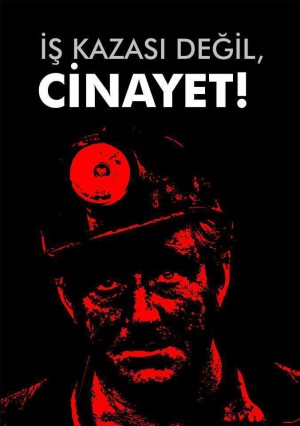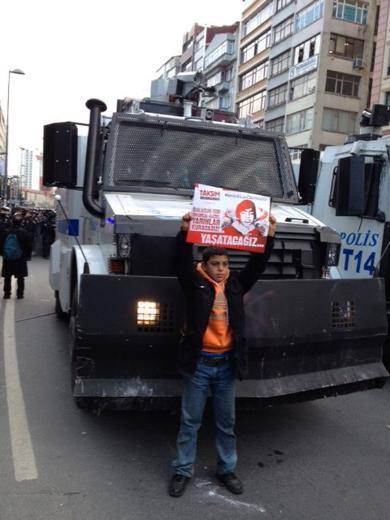According to our compilation based on news items published in media, reports of labor organizations, and testimonies of workers and their families, at least 1235 workers died in 2013.
Work murder, not work accident …
As The Assembly for Workers’ Health and Work Security, we document deaths at workplace. The criteria for our documentation is as follows:
1- According to Turkish Statistical Institute data, approximately 30 614 000 people were employed in 2013. In our reports, we do not use the legal restrictions. This means, we include work accidents of all the workers, including domestic work, security sector, shopkeepers, farmer, public sector, and non-citizen workers.
2- Laws use the term “work health”. This wording designates a mindset based on the health of work (that is, the efficiency of the enterprise, its profitability etc) and not the health of the worker. Therefore, we will use “worker’s health” in our report.
3- Our main assumption is that all work accidents are avoidable. As workers’ deaths can be prevented, we do not use “work accident” to define the incidents and instead use “work murder.”
4- We do not focus only on workers with social insurance who died at the workplace or in the shuttle buses. We also include the death of precarious and non-insured workers; and we consider all the labor process, including transportation, alimentation etc.
5- Due to our lack of personnel as the Assembly, we have access only to a part of the deaths. Therefore, we emphasize the words “at least” in our report.
Work murders by sector
Construction (including road construction): 294
Agriculture and Forestry: 198
Transportation: 131
Trade, Offices, Education, Cinema: 95
Mining: 93
Metal works: 79
Municipalities and Public Services: 36
Accommodation and Entertainment: 24
Food and Sugar: 23
Cement, Soil, Glass: 22
Petrochemical works and Rubber: 19
Timber and Paper: 19
Docks, Harbors and other sea sectors: 18
Health and Social Services: 15
Media and Journalism: 7
Communications: 4
Work murders are concentrated in areas of seasonal employment, where trade unions do not exist, and in areas under precarious working conditions. We should further add that in sectors such as textile, metal and food production, if the work murder happened inside the factory, we have less chance of obtaining that information.
Work murders by cause
Traffic and car accidents: 433
Collapse and wreckage: 222
Fall: 189
Explosion and fire: 79
Electric shock: 79
Poisoning and suffocation: 60
Getting hit by objects: 33
Ruptures: 11
Others (including heart attack, suicide, lightning, assault): 129
Work murders by gender
Female: 103
Male: 1130
(unknown) 2
Work murders by age
14 and under: 18
15-17: 41
18-27: 249
28-50: 594
over 51: 189
(144 could not be determined)
Children workers
Turkish law defines “those who are 14 years old but under 15 years old, and who finished her/his basic education” as children workers; and “those who are over 15 and under 18 years old” as young workers. However, children enter the labor market at an earlier age to “earn their bread.”
According to a report published by the Ministry of Family and Social Policies, among the 15 247 000 children of ages between 6-17, some 893 000 work. Although forbidden 292 000 children aged between 6 and 14 are stated to work too. Work prevents children from going to school. According to the report, 20% of those 292 000 children do not continue their compulsory education. Same applies to high schools, as 66% of young workers quit school for work.
The main reason of child labor is the poverty of their families. Child labor is also a prototype of unregulated, precarious work. In 2013, child and young workers constitute 5.4% of the work murders. This means that of every 20 workers who lost their lives, one is a child or young worker who works due to poverty.
On the other hand, the Social Security Institution states that only 1 young worker died in 2012. Similarly, as a response to a parliamentary question, the Minister of Work and Social Security declared that in 2012 only 5960 children were working. These statements show a clear attempt of state authorities to hide child labor.
One method of child labor is seasonal employment in construction and agriculture. Especially girls are employed for picking the crops; and they are exceptionally over-consumed as girls are also expected to the housework. Boys are employed more on construction, in which they are expected to do hard work together with adults.
Apprenticeship and internships for child and young workers operates via a cooperation of the Ministry of Education and enterprises in industrial zones. Long working hours, intensive work and low wages are characteristic of this type of child employment. As apprentices, half of the grade of the student is given by his employer. Hence, intensive work and low wages are the rule. Vocational schools have become subcontractors of big businesses. A new restructuring of vocational schools (a joint work of Ministry of Education, Ministry of Labor and Social Security, and European Union) emphasized reforms at schools based on the priorities of markets. Accordingly, the “quality” of high schools students are determined by their performance; which brought about lack of control over work security. In industrial zones, young workers are exposed to poisonings, explosions and ruptures. They further suffer professional diseases due to carrying heavy weights, bad air quality and chemicals at work.
Female workers
Female worker murders are understated in state statistics. According to Social Security Institution data, only 9 women died at work in 2012.
Our data shows that in 2013, 103 woman laborers lost their lives at work. This corresponds to 8.4% but we shall emphasize again: We do not know. Seasonal agricultural labor and domestic work remain undocumented in official statistics, and we have limited access to the real conditions of female workers.
Almost half of women workers are employed in agriculture and the big majority also does gratis housework for her family. While working in the farm all day long, women are also taken responsible to take care of the house and children.
Among women workers, 15% work in industry and 35% work in the service sector. Most of these women are also doing gratis housework.
İletişim
http://www.yanginkulesi.org
http://www.guvenlicalisma.org
http://www.facebook.com/guvenli.calisma
https://www.facebook.com/yanginkulesi
guvenlicalisma[at]gmail.com
İstanbul İşçi Sağlığı ve İş Güvenliği Meclisi
***
Editorial note:
The Turkish original of this report, written by The Assembly for Workers’ Health and Work Security (İşçi Sağlığı ve İş Güvenliği Meclisi), was published on January 13th, 2014, months before the mine explosion in Soma. The original report consists of 20 pages and contains a very detailed analysis of the working conditions in Turkey, including the full list of workers who died at work. As part of our “Why revolt in Turkey?” series, we translated parts of it that we thought were exceptionally indicative of the conditions of the working class in Turkey.


